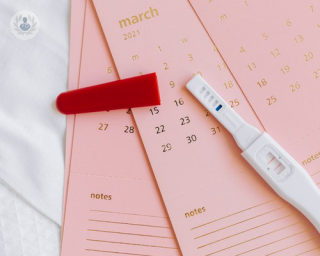Semen analysis
Mr Parijat Bhattacharjee - Obstetrics & gynaecology
Created on: 12-29-2015
Updated on: 02-13-2024
Edited by: Aoife Maguire
What is a seminogram?
A seminogram, also called spermogram or semen analysis, is a diagnostic test to analyse the quality of semen. A semigram measures qualities such volume, liquefaction, viscosity, colour and pH of the semen, and, on the other hand, the concentration, mobility, vitality, morphology and presence of epithelial cells or leukocytes of the spermatozoa.

What happens during a seminogram?
The patient must collect a sample of semen in a sterile bottle after having urinated and washed their hands and genitals. It is important to obtain the total sample of the ejaculate, as otherwise the analysis will not be representative and will not be considered valid. Once the sample is collected, it must be delivered to the clinic for analysis.
If the sample is taken at home, it must delivered to the clinic within an hour. During transport, the temperature of the sample must fall below 5ºC.
Why is a seminogram performed?
A seminogram is used to diagnose male infertility and determine what type of infertility is present. This can help the medical team assess the chances of a successful pregnancy and the best course of treatment.
When to undergo the analysis?
Semen analysis is typically recommended for couples experiencing difficulty conceiving after one year of unprotected intercourse.
Preparing for the seminogram
To prepare for the seminogram, it is important that:
- you do not ejaculate for 4-5 days before the sample is taken
- no ointments are applied during the eight hours prior to collection of semen
What sample is required?
A semen sample is required for semen analysis. It is collected into a sterile container provided by the laboratory.
What are the normal values?
Normal values for semen analysis include:
Sperm count: 15 million sperm per millilitre or higher
Sperm motility: At least 40 per cent of sperm showing forward movement
Sperm morphology: At least 4 per cent of sperm with normal shape and structure
Semen analysis parameters
| Parameter | Normal values |
| Sperm count | ≥ 15 million/mL |
| Sperm motility | ≥ 40% with forward movement |
| Sperm morphology | ≥ 4% normal morphology |
This table summarises the normal values for key parameters evaluated in semen analysis.
What do altered values signify?
Altered values in semen analysis may indicate potential issues with male fertility, such as low sperm count, poor sperm motility, or abnormal sperm morphology. Further evaluation by a fertility specialist may be required to determine the underlying cause and appropriate treatment options.
What could abnormal results mean?
The main problems that can be diagnosed in a seminogram and that lead to infertility are:
- oligospermia - low sperm count
- azoospermia - absence of sperm
- asthenozoospermia - problems of sperm mobility
- teratozoospermia - problems with the shape of the sperm morphology
- hypospermia - low seminal volume
After diagnosis you will have a consultation with your fertility specialist about the best treatment options moving forward. This could include the standard treatment of in vitro fertilisation or a more specialised treatment such as ICSI or IMSI.


